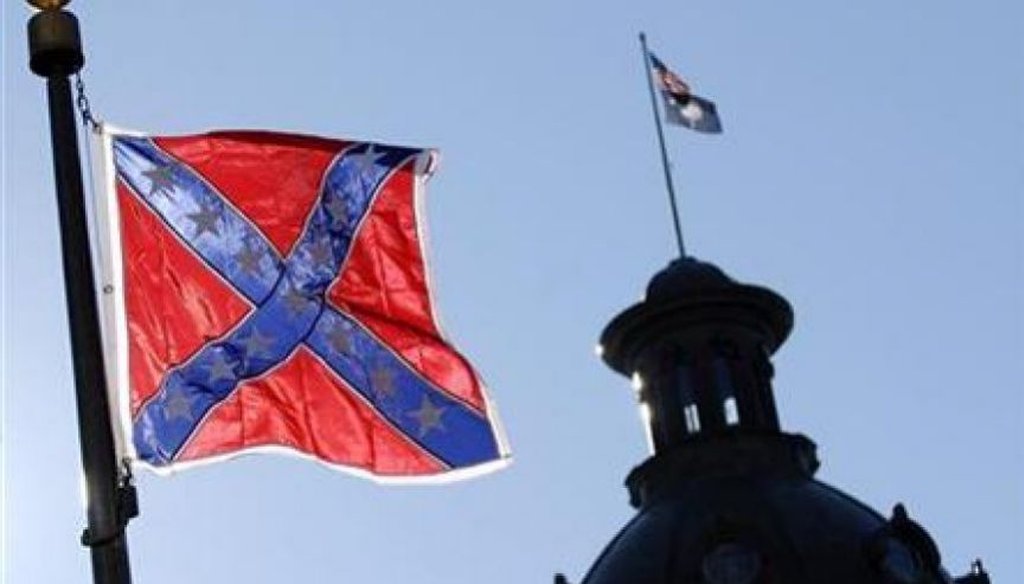Get PolitiFact in your inbox.

The Confederate battle flag flies at a memorial in front of the South Carolina state House. (AP)
The brutal killing of nine African-Americans at a historic Charleston, S.C., church Wednesday has fueled new calls to remove the Confederate battle flag from the grounds of the South Carolina statehouse.
What are the facts about the flag and its history?
PunditFact and PolitiFact delved into a pair of claims made over the weekend.
The first comes from Rep. James Clyburn, a South Carolina Democrat who participated in discussions that led to the flag remaining on statehouse grounds in 2000.
On Meet the Press, Clyburn said that the compromise to allow the Confederate flag to fly in front of the state capitol in Columbia wasn’t the original compromise at all.
"The compromise was to put that flag in front of the Wade Hampton office building next to the Wade Hampton statue," Clyburn said. "What happened was when some people rejected the compromise, the Legislature, out of defiance, put that flag where it is today in front of the statehouse. That is not what the compromise was. The compromise was to put it on the back side of the statehouse, out of public view so it would not have any appearance of sovereignty."
Clyburn is correct that there were other proposed compromises, including one that would move the flag to a less visible location. But he goes too far suggesting there was agreement for one plan before the Legislature changed tack.
Clyburn’s claim rates Mostly True.
We reached out to Clyburn’s office and did not hear back by the time we published. However, we did talk to Rep. Gilda Cobb-Hunter, the South Carolina House Democratic minority leader in 2000.
Cobb-Hunter remembers the plan Clyburn had in mind, but she also remembers that there were several ideas on the table.
"There were a number of conversations back in 2000 held by a number of different people," Cobb-Hunter said. "It would not be accurate to say that there was one plan that had reached a consensus."
Cobb-Hunter and a top House Republican lawmaker had co-sponsored a proposal for a new installation on the statehouse grounds that they called the Circle of Flags, in which the Confederate flag would have been one of several from South Carolina’s history.
Another approach suggested the flag move to the state’s Confederate Relic and Military History Museum.
The plan to place it by the Wade Hampton statue (Hampton served as governor and U.S. senator in the 1870s and 1880s) did have significant support. In February 2000, then-governor Democrat Jim Hodges got behind the move, and at the time, Cobb-Hunter said it was a viable option.
But it never caught on, not with House Republicans, nor with the National Association for the Advancement of Colored People.
Angela Ledford co-authored a study on the flag controversy while getting her doctorate at the University of South Carolina. Now a political scientist at the College of St. Rose, Ledford remembers that plan as "an informal agreement with some of the legislative leadership."
The compromise that emerged -- first in the state Senate and then affirmed in the House -- sent the flag to its present location by the monument to the Confederate Soldier. In a bit of legislative log-rolling, the Senate passed the bill after the House approved making Martin Luther King, Jr. Day a state holiday. South Carolina was the last state in the country to officially recognize MLK Day.
The majority of African-American House members voted against the bill, and the NAACP opposed it as well.
Another point we heard many times was that while the U.S. and state flags have been lowered to half-staff, the Confederate flag has not. CNN reporter Jean Casarez explained why.
"By law, it must fly at a height of 30 feet," Casarez said. "Any changes — taken down, or even at half-staff, if that can be done — must be passed by a supermajority of the General Assembly."
That claim rates True.
South Carolina’s Code of Laws allows the governor to order the lowering of the state and U.S. flags flying atop the capitol building to half-staff, which Gov. Nikki Haley has done. But according to her spokesperson, it’s the Legislature, not the governor, who has the legal authority to alter the Confederate flag.
Title 1 Chapter 10 of state law spells it out, saying that "the flag authorized to be flown at a designated location on the grounds of the Capitol Complex is the South Carolina Infantry Battle Flag of the Confederate States of America. This flag must be flown on a flagpole located at a point on the south side of the Confederate Soldier Monument, centered on the monument, 10 feet from the base of the monument at a height of 30 feet."
The law goes on to say that any change must be approved by "a two-thirds vote on the third reading of the bill in each branch of the General Assembly."
The two-thirds vote applies to both permanent changes and temporary adjustments alike, according to Democratic State Rep. James E. Smith, who doubts the law’s constitutionality and who’s been working on removing the flag since it was first moved to the grounds.
While the flag can be lowered physically, no one we spoke to could recall a time -- be it Memorial Day or 9/11 -- when it wasn’t flying at full-staff.
"It’s not a flag of sovereignty, it’s a veterans’ battle flag. … Should that flag be on the dome, which it should, it would be lowered, but it’s not," said Thomas Leland Summers, commander of the South Carolina division of the Sons of Confederate Veterans, who noted that the Confederate flag wasn’t lowered to honor Civil War anniversaries.
Smith, a Democratic state lawmaker, agreed, but also said: "That’s beside the point. It shouldn’t be flying anyway. If we were to lower it, it would give it the status of a sovereign flag, a status greater than it deserves. It should just be furled."
One other point we heard Sunday about the flag: That it hasn't been flying on the South Carolina statehouse ground for that long. Here's how Eugene Robinson described it on Meet the Press.
"Do you know when that flag was first flown at the Columbia statehouse in Columbia?" he asked during an interview on Meet the Press June 21. "1961 … it was a middle finger directed at the federal government. It was flown there as a symbol of massive resistance to racial desegregation. Period.
"It was only after Brown vs. Board, after Little Rock, after desegregation began, that South Carolinians put up the flag on the statehouse, that other states in the South adopted the battle flag as part of their state flags," Robinson said. "So it was massive resistance."
Robinson is right about the date, but the claim that the flag was hoisted as a "a symbol of massive resistance to racial desegregation" is a bit murky. Overall, we rated Robinson's claim Mostly True.
Daniel Hollis, a member of the commission responsible for planning South Carolina’s Confederate War Centennial, recalled the exact day the flag was first hoisted during an interview published in 1999.
Hollis said the flag itself went up on April 11, 1961, for the opening of the Civil War centennial "at the request of Aiken Rep. John A. May."
"May told us he was going to introduce a resolution to fly the flag for a year from the capitol. I was against the flag going up," Hollis said, "but I kept quiet and went along."
The resolution was approved in 1962, but never included a date for the flag’s removal.
"It just stayed up," Hollis said. "Nobody raised a question."
As for why lawmakers decided to display the flag, we asked K. Michael Prince, author of Rally 'Round the Flag, Boys: South Carolina and the Confederate Flag, if he could pinpoint the root cause.
"As far as I've been able to determine, the bare facts … provide no clear evidence either way," Prince said. "It's possible that nobody had anything else in mind other than commemorating the war. But we would be remiss not to take the larger context into consideration in judging the meaning of the display."
Our Sources
See individual fact-checks.




























































